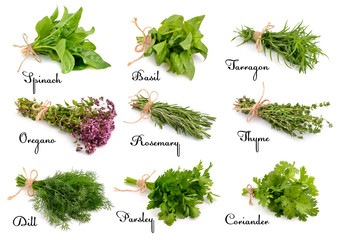Cooking with Herbs

Herbs
I often get calls from my friends and family with cooking questions, one of the most frequent questions I get asked is, “I’m cooking such and such, what herbs should I use?” Talk about an open-ended question with infinite answers.
Let’s start with a simple definition of what an herb is. An herb is a plant that is valued for flavor, scent, or other qualities. That’s a rather simplistic definition for something that is so essential to successful cooking.
Let’s get back to the question…..which herbs should be used when cooking? Well, there are many different types of herbs, (dry and fresh), that can contribute to a dish. Different herbs go with different types of food, and the only way to figure out what works best with certain types of food is to experiment. That’s right, go to your local grocery store, buy as many fresh herbs as you can, and start cooking.
There are no right or wrong ways to mix, and cook with herbs, it’s all a matter of personal preference and taste; it’s subjective. Some chefs may not agree saying, “You would never put fresh rosemary on Chilean Sea Bass.” Well, he or she may not like that particular taste combination, but you might. Furthermore, a good Chef would never discourage a CIT (chef in training) not to try new taste combinations.
Before we get into a list of herbs, there is a rule of cooking with herbs that should always be followed. If you’re using herbs/spices that are dried, they can be added during the cooking process to help enhance a dish. If you’re working with fresh herbs, they should be added upon completion of the dish to preserve the freshness and aromatic compounds. If fresh herbs are over-cooked they can become bland and absent.
Most importantly, always remember to salt and pepper what you’re cooking! This is the first lesson they teach in culinary school. Salt isn’t an herb or spice; it’s considered a mineral. Pepper is a spice.
Here is a list of herbs:
| HERB | GREAT COMBOS | SUBSTITUTES |
| Basil | Most vegetables. Anything to do with tomatoes. | Marjoram, Mint, Anise |
| Bay | Used mainly in soups and stews, where the flavor can develop. | Thyme |
| Chives | Salads and Cold Plates | Scallions / Green Onions |
| Cilantro | Salsa, Asian and Caribbean Dishes | Flat-leaf Parsley. Spicy Basils. |
| Dill | Fish, Chicken, Eggs, Salad, Beans, Carrots, Cucumbers, Cabbage, Potatoes, Pickles & Sour Cream or Yogurt Dips. | Caraway |
| Lemon Grass | Thai Dishes, Chicken, Beef, Curry, often combined with coconut milk. | Lemon Zest |
| Lemon Verbena | Fish, Poultry, Marinades, Salad Dressing, Jams, Sauces, Teas. | Lemon Grass, Lemon Zest |
| Mint | Lamb, Eggplant, Desserts, Teas, Salads, Vegetables, Fruits. | Spicy Basils |
| Oregano | Beef, Chicken, Pasta, Tomatoes, “Blacken” Rub | Marjoram, Mint, Basil |
| Parsley | Salads, Tabbouleh | Cilantro |
| Rosemary | Chicken, Fish, Lamb, Pork, Potatoes, Stews | Oregano, Spicy Basils |
| Sage | Poultry, Beans, Stuffing, Pasta | Thyme, Summer Savory |
| Savory (Summer) | Vegetables, Fruits, Cheese | Winter Savory, Marjoram |
| Tarragon | Chicken, Eggs, Fish | Anise, Fennel |
| Thyme | Poultry, Eggs, Stews, Vegetables | Lemon Basil |
This is by no means a complete list of herbs. There are many different types of spices and herbs that can be used in cooking. If you’re feeling adventurous try ethnic markets and shop on-line; you never know what you’re going to come across!
Happy cooking!
Chef Chuck Kerber






 in <b>/var/www/vhosts/cooksandeats.com/httpdocs/wp-content/themes/CooksandEats/sidebar.php</b> on line <b>1</b><br />
/wp-content/themes/CooksandEats/images/side-logo.png)



 in <b>/var/www/vhosts/cooksandeats.com/httpdocs/wp-content/themes/CooksandEats/footer.php</b> on line <b>13</b><br />
/wp-content/themes/CooksandEats/images/back-to-top.png)